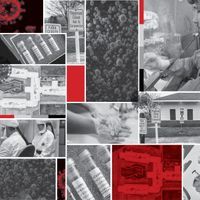Login
Subscribe404
Not Found
Is this what you were looking for?
tag pcr microbiology genetics genomics ecology developmental biology

EvaGreen® Dye: The Swiss Army Knife of qPCR
Biotium | Mar 1, 2024 | 7 min read
A green fluorescent dye with a novel DNA binding mechanism improves signal-to-noise in different DNA amplification assays.

Engineering the Microbiome: CRISPR Leads the Way
Mariella Bodemeier Loayza Careaga, PhD | Mar 15, 2024 | 10+ min read
Scientists have genetically modified isolated microbes for decades. Now, using CRISPR, they intend to target entire microbiomes.

Genomics 101
Jeffrey M. Perkel | Dec 1, 2012 | 4 min read
Undergraduate students delve into genomics and synthetic biology thanks to a new breed of technologically advanced courses.

The Inside Guide: The Gut Microbiome’s Role in Host Evolution
Catherine Offord | Jul 1, 2021 | 10+ min read
Bacteria that live in the digestive tracts of animals may influence the adaptive trajectories of their hosts.

The Genetics of Society
Claire Asher and Seirian Sumner | Jan 1, 2015 | 10 min read
Researchers aim to unravel the molecular mechanisms by which a single genotype gives rise to diverse castes in eusocial organisms.

What’s the Deal with Bacterial Nanotubes?
Sruthi S. Balakrishnan | Jun 1, 2021 | 10+ min read
Several labs have reported the formation of bacterial nanotubes under different, often contrasting conditions. What are these structures and why are they so hard to reproduce?
Genetic Parasites and a Whole Lot More
Barry Palevitz | Oct 15, 2000 | 10+ min read
Photo: Ori Fragman, Hebrew University Hordeum spontaneum, the plant studied for BARE-1 retroelements. With genome sequences arriving almost as regularly as the morning paper, the public's attention is focused on genes--new genes to protect crops against pests; rogue genes that make bacteria resistant to antibiotics; faulty genes that, if fixed, could cure diseases such as muscular dystrophy. What many people don't realize is that genes account for only part of an organism's DNA, and in many c

Follow the Coronavirus Outbreak
The Scientist | Feb 20, 2020 | 10+ min read
Saliva tests screen staff and students at University of Illinois; Study ranks species most susceptible to SARS-CoV-2 infection; COVID-19 clinical trials test drugs that inhibit kinin system
Epigenetics: Genome, Meet Your Environment
Leslie Pray | Jul 4, 2004 | 10+ min read
©Mehau Kulyk/Photo Researchers, IncToward the end of World War II, a German-imposed food embargo in western Holland – a densely populated area already suffering from scarce food supplies, ruined agricultural lands, and the onset of an unusually harsh winter – led to the death by starvation of some 30,000 people. Detailed birth records collected during that so-called Dutch Hunger Winter have provided scientists with useful data for analyzing the long-term health effects of prenat
Prospecting for Gold in Genome Gulch
Amy Adams | Apr 14, 2002 | 9 min read
The human genome is much like the American West of the 1850s: Everyone wants a piece of the pie. Similar to gold prospectors of 150 years ago, biotech and pharmaceutical companies, and even universities, are frantically searching for the nuggets of gold that will help them find the mother lode—a gene whose function is sufficiently marketable to make all of the preliminary research worthwhile. Companies that do strike gold get to introduce new classes of drugs to the market. Others hope to